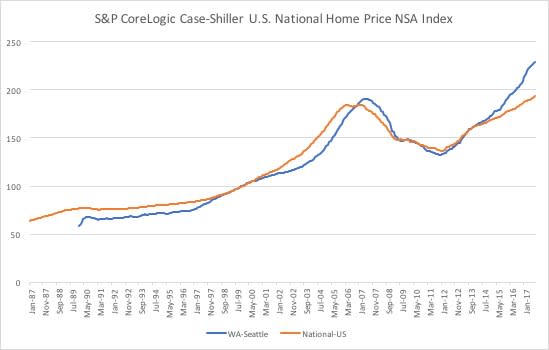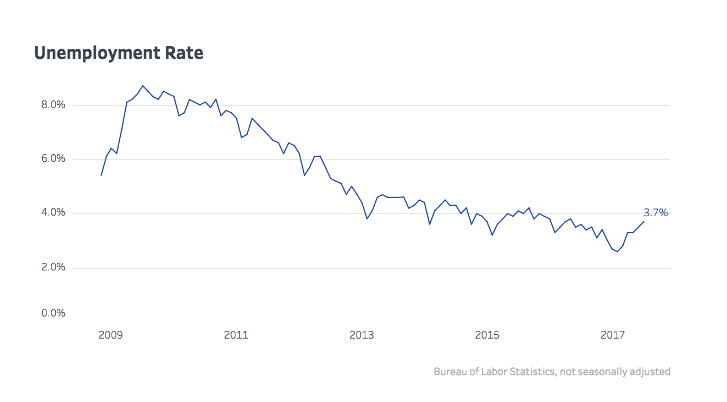The hottest housing market of 2017
The hottest real estate market in the nation is Seattle.
Not only is Washington’s largest city home to internet juggernaut Amazon (Yahoo FInance’s Company of 2017), it also holds the title for the city with the fastest-growing home prices. Since September 2016, Seattle has been leading the S&P CoreLogic Case Shiller Home Price 20-City Composite Index and has maintained that spot each month. There’s no doubt that Amazon has been fueling the city’s real estate market but population and job growth coupled with high demand and low inventory are also lifting prices.
“Seattle is consistently outpacing the rest of the country,” said Lawrence Yun, chief economist at the National Association of Realtors. “High-tech workers are concentrated or were concentrated in the San Francisco, Silicon Valley area where prices got way too high. Seattle provides an alternative for people.”
Median sales price in Seattle was $478,500 in the third quarter of this year, up 13.4% from the same time last year, according to the NAR. That’s not exactly cheap since the median sales price in the U.S. was $254,000, but it’s still half of the price of a home in San Francisco, where the median sales price was $900,000.
Seattle has been at a 5.9% annual price increase or greater since November 2011, “that’s when mostly everything had bottomed out,” and at a 10.5% increase or more for a year and past three quarters, said David Blitzer, managing director and chairman of the index committee at S&P Dow Jones Indices.

“Home prices are driven by population and employment,” said Blitzer.
For the first time since 2013, Seattle had the fastest one-year population growth rate, 3.1%, among the 50 most populous cities in the U.S. in 2016, according to an analysis of U.S. Census Bureau data by The Seattle Times. Since the start of the decade, Seattle added an average 15,658 people a year, and in 2016 it topped 700,000.
Meanwhile, the unemployment rate has been below the national rate, hovering around 3% for a few years now. Job growth has been strong mainly due to tech companies like Amazon. It helps that Starbucks is also headquartered in Seattle and Microsoft’s home is in nearby Redmond, Wash. Microsoft recently revealed multibillion-dollar plans to redevelop its 500-acre campus. Last year, Amazon had the most job postings in Seattle with 19,766 openings to fill, according to job market data provider Burning Glass Technologies. The University of Washington and Starbucks were far behind with 5,156 and 1,992 job postings, respectively.

“We see evidence that these large companies with a lot of employees contribute to a strong housing market,” said Sarah Mikhitarian, an economist at Zillow, an online real estate database company headquartered in Seattle. “The strong labor market drives people to want to live there. At the same time, strong jobs put more pressure on price of homes.”
According to Amazon’s website, 15% of its employees live in Seattle and 20% of its workers walk to work. Microsoft didn’t break out how many workers it has in Seattle, but its website said the company has 47,121 in the Puget Sound area of Washington.
Amazon’s fortune “flows down to employees who have extra financial resources to purchase property,” said Yun.

Tech workers are flocking to Seattle
Seattle has become a top destination for professionals in the tech industry, not just folks who want to work for Amazon. Seattle tech firms added 23,575 jobs in 2015 and 2016, accounting for 93% of all office jobs in the city created during that time period, according to a report by real estate firm CBRE. The total number of tech jobs created topped any other major office market in the U.S.
It helps that tech workers who live in Seattle appear to have more disposable income than those situated in other metropolises. A report by LinkedIn and Zillow found that Seattle tech workers who own their homes can expect to have about $2,000 more in disposable income each month than tech workers in the Bay Area. Seattle tech workers keep an average of 59% of their income after paying taxes and housing, while San Francisco Bay Area tech workers pocket only 37%. Those figures made Seattle the No. 1 “sweet spot” for tech workers looking for a job and housing.
High demand, low inventory
But it’s not easy to find a home to buy in Seattle. There’s a scarcity of homes for sale in Seattle. Eighty percent to 90% of new home listings sell within the first 30 days of the posting, normally only 30% of listings sell, said Lennox Scott, chairman and CEO of brokerage John L. Scott Real Estate.
“Buyers are waiting for each new listing to come on the market,” said Scott. “We are down to about 15 days of inventory in the mid-price range [$500,000-$600,000] of homes.”
Similarly, even first-time homebuyers will have a hard time finding a place to buy. There are 35% fewer homes online than a year ago in the entry-level range, homes with a median sale price of $293,000, according to Zillow. And Seattle isn’t exactly the go-to city to find a deal on your first home. An entry-level home in the U.S. is almost half the price of Seattle home at $118,200.
“That shows you how hot the Seattle market is,” said Mikhitarian.
Further exacerbating the supply of for-sale homes in the market is the lack of new condo developments. A majority of new construction in Seattle is for apartments for rent. That’s where investor money has been focused on, said Scott, who added that there isn’t much activity in condo projects.
As a result homeowners are hesitant to put their place on the market in fear of not being able to find a new home to buy before someone snaps up their current home, said Scott. “There’s seller gridlock,” he said.
Sign of a slight cooling down
Most think home prices will remain elevated since the city is still considered affordable compared with the nation’s other tech hubs and inventory will remain low. However, a slow down of tech hiring may change things. According to The Seattle Times, the city’s largest employer Amazon may be pulling back a little in their hometown. During the week of Dec. 3, Amazon had 3,503 job postings — the lowest in three years and down from more than 9,000 just six months earlier.
But, so far, all signs indicate that the city’s housing market will remain sustainable. There might be a slight slowdown, given that employment growth is projected to slow through 2020. NAR’s Yun said we may see single-digit rate of appreciation instead of double digits in 2018.

“The Seattle market is a magnet because of its natural beauty,” said Scott, touting the city’s mild temperatures and lush environment. “That’s why individuals like to move here when they do have a job opportunity. It is an attractive city.”
It’s called the Emerald City for a reason.
—
Amanda Fung is an editor at Yahoo Finance.
